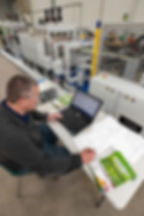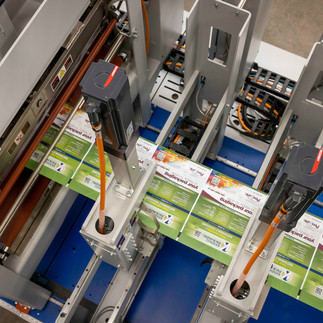Next-gen Converting Machines Crush Legacy Performance Limits Using PC Control
- James Figy
- Mar 28, 2023
- 7 min read
Updated: Feb 2, 2024
CMD’s redesigned stand-up pouch system delivers faster changeovers, more intuitive operation and less scrap in zippered packaging using automation technologies from Beckhoff
Small changes, huge gains – experienced converters have seen how one leads to the other. Converters understand how many steps and purposeful decisions go into transforming rolls of film into bags, pouches or other types of packaging.
For more than 40 years, Appleton, Wisconsin-based CMD Corp. has delivered flexible, high-speed converting and packaging equipment. CMD machines produce nearly every drawstring trash bag produced in the U.S., with international market share growing rapidly. CMD also offers solutions to industries like renewable energy. This broad portfolio harnesses technologies to save time and cut costs. With a proven track record of tailored solutions, CMD lives up to its name, which is an acronym for Custom Machinery Design.
Making impactful changes requires flexible automation technology, according to Scott Fuller, Product Line Manager, Intermittent Motion Products at CMD. “Every converter is looking for an edge,’” Fuller says. “When we get customer requests that are twists to the established process, our technology needs to rise to the challenge.”

Like its converter customers, CMD stays on the lookout for new technologies that provide the machine builder with unique competitive advantages. While the earlier iterations of the 760-SUP stand-up pouch system were well received in the market, CMD thrives on continued innovation. This is clear from the numerous patents displayed throughout the CMD Technology Center, proving the company’s long-term commitment to innovation. Outdated machine control and networking were holding CMD back as they had pushed the legacy platform to the limit. Increasing controller performance levels multiplied costs and the technologies were too rigid and difficult to adapt to custom requests.
The CMD engineering and product teams began working on a redesign of the 760-SUP in late-2021. They aimed to solve these performance limitations and complete the machine as their main booth highlight at PACK EXPO International 2022. Rather than make incremental adjustments, they decided to redesign the machine from the ground up. That meant many mechanical changes and a new control platform. The design highlights how CMD skillfully implemented customer feedback and market research, Fuller explains: “The market is telling pouch machinery OEMs that their systems need to provide even faster changeovers and more intuitive operation – as well as less scrap.”
“We now have a superior automation platform, and our customers can keep looking to CMD for that competitive edge.”
Standing up to motion control limitations

“The first change we made to give converters an edge was ‘taking off the hood,’ so to speak,” Fuller says. Using light curtains instead of physical barriers supported an open design. Operators can step into the machine for changeovers, which is more user friendly and simplifies the identification of components. “Operators can now make more straightforward adjustments via our HMI, for example, to change force applied without shimming or adjusting springs,” he adds.
Second, the company focused on the actual sealing technology. Bag or pouch converting machines typically fold material the same way, but sealing requires many different specifications for each film and process. “Our sealing and zipper crush technologies support high-performance handling of legacy films,” Fuller says. “But the stand-up pouch machine delivers advanced capabilities for emerging recyclable pouch materials and new digital printing methods.”
Both design changes led to better, faster ROI for end users. To illustrate this, CMD has an ROI calculator on its website to show the details. The design changes also required automation technology with enough power and speed to ensure high-quality, repeatable operation as well as flexibility so converters can continue refining their processes into the future.
Meeting these technical requirements was critical as CMD evaluated new automation platforms. Cost and support capabilities from the automation vendor also played decisive roles, according to CMD Electrical Engineer Jason Plutz. In the end, CMD selected EtherCAT and PC-based automation from Beckhoff for the next-generation 760-SUP.

“Not only was Beckhoff less expensive in our application, but also the technology was a major leap ahead,” Plutz says. “We made bigger advances than we had hoped.”
Complete control for converting machines
CMD worked closely with Beckhoff’s local engineering team on the 760-SUP redesign. Beckhoff Regional Sales Manager Don Seichter, Applications Engineer Dave Ross and General Technical Support Rob Lecheler assisted in specifying components and providing support while migrating to TwinCAT 3 automation software.
“CMD already had a firm foundation of engineering expertise,” Ross says. “That allowed them to rapidly move from their previous platform to Beckhoff. For example, they already used object-oriented programming (OOP) paradigms, which sped up conversion of existing code.”
TwinCAT provides an end-to-end engineering and runtime environment for all aspects of machine control from PLC to IoT. Integrated into Microsoft Visual Studio®, TwinCAT empowers engineers to program in the right language for their application, whether that is one of the IEC 61131-3 standards with object-oriented extensions, predefined or custom function blocks, or computer science standards. TwinCAT Scope, Drive Manager 2 and other pieces of the software toolkit also enhanced CMD’s capabilities in design and commissioning.
“After wiring the machine, Drive Manager 2 helped us quickly tune the motors, including third-party VFDs. We didn’t have to adjust any motor parameters later. That surprised me,” Plutz says. “The Scope tool helped us capture and analyze data on startup – with incredible speed and a huge set of variables that other platforms don’t offer. With TwinCAT, the tools are all in one software platform, which is preferable to the multiple packages we used in the past.”
The TwinCAT runtime is on a CX2033 Embedded PC from Beckhoff. Backed by a Beckhoff uninterruptible power supply (UPS), the CX2033 serves as the sole machine controller for the 760-SUP. A dual-core AMD Ryzen™ processor supplies ample performance, according to Plutz: “We’re running at about 15% CPU load on just one of the controller’s two cores. We’re scanning extremely quickly with the CX2033, and we could run it even faster. I’ve never seen performance like this with previous controllers.”
Drive safe – and drive fast with EtherCAT
The 760-SUP machine features a continuous motion section for feeding and folding film as well as an intermittent motion section for sealing and zipper crush. In the past, a gusset punch on the continuous side required additional hardware and excessive engineering efforts to synchronize actuation with the material position. Here, the EtherCAT industrial Ethernet system further boosted performance.

“EtherCAT’s speed, combined with deterministic control and an encoder module from Beckhoff, seamlessly incorporated the incoming material position and punch with standard I/O modules,” Seichter says. “The Beckhoff solution just worked.”
EtherCAT supports free selection of network topology, up to 65,535 nodes on one system and connectivity to more than 30 other protocols with the simple addition of a gateway. CMD appreciated the wide selection of EtherCAT Terminals from Beckhoff. EL3314 and EL3318 analog input modules enable compact, direct connection of thermocouples for accurate temperature control of the sealer bars. Another space-saving technology, the EK1914 EtherCAT Coupler offers standard digital inputs and outputs alongside two safe inputs and two safe outputs, all built in. This means CMD can distribute a small amount of TwinSAFE I/O with integrated functional safety capabilities on each tool in the machine line.
Using the Safety over EtherCAT (FSoE) protocol, TwinSAFE communicates safety data via the standard EtherCAT network using a TÜV-certified “black channel” approach. This allowed CMD to easily incorporate the necessary light curtains, E-stops and other safety devices to protect operators while maintaining an open machine design. “On our previous design, we had to run cabling from each tool back to a standalone safety system. TwinSAFE really cleaned that up,” Plutz says.

The high synchronization of EtherCAT extends to motion-intensive applications. The CMD team reaped results when using the industrial Ethernet fieldbus with the AX8000 multi-axis servo system and various AM8000 servomotor solutions.
“We relied mostly on AX8206 servo drives, along with others,” Plutz says. “One AX8000 drive can power two servomotors. They also require no independent fuse, reduce wiring via the tool-free, pluggable AX-Bridge and even offer a VFD mode. Above all, the AX8000 and AM8000 servo technologies offered incredible performance with high-resolution feedback in a space-saving design.”
Repeatability and high performance are in the bag
Before film materials make it to CMD’s machines at converting facilities, they must undergo extrusion, printing and lamination. So waste material is at its most expensive point, Fuller explains: “We pay close attention to scrap and the process itself, so our customers can be confident in their pouches before they get to the CPG.” But that’s not the only waste they try to eliminate. The CMD engineers remain cognizant of setup time and downtime.
Switching to Beckhoff’s New Automation Technology platform reduced test and debug times by several weeks. EtherCAT accelerated commissioning by scanning in all devices on the network. Use of Drive Manager 2 reduced the time needed to tune motors by a factor of three. The Beckhoff technologies ensured precise, repeatable motion control for the zipper crush, along with more intuitive operation and changeovers. The safe, open machine design enabled by TwinSAFE led to 40% faster changeovers than competitive machines. All together, the redesigned system ensures high throughput with uptime rates higher than 90%, according to CMD customers.

Beyond that, PC-based automation technology and EtherCAT leave room to grow with CMD and its customers. CMD intends to leverage the inherent connectivity of PC-based control to implement edge computing and IoT functionality in the future. Support from the local Beckhoff team will continue to be crucial as it was for the 760-SUP redesign. “Dave and Rob helped us hit our timeline so the machine could debut at PACK EXPO,” Plutz says. “Whenever we need their help, they are there.”
Moving forward, CMD plans to migrate even more of its machine lines to Beckhoff. “With their automation technologies, the future looks clearer for us,” Fuller says. “We don’t face the same limitations of previous control systems. Beckhoff allows us to choose what we need as we develop our machines. We now have a superior automation platform, and our customers can keep looking to CMD for that competitive edge.”
Looking for new automation solutions to help crush your packaging machine redesign? Reach out to your local Beckhoff sales engineer today.

James Figy is the Marketing Content Leader at Beckhoff Automation LLC.
A version of this article appeared in Flexible Packaging.





